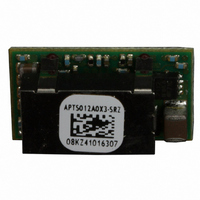APTS012A0X3-SRZ Lineage Power, APTS012A0X3-SRZ Datasheet - Page 15

APTS012A0X3-SRZ
Manufacturer Part Number
APTS012A0X3-SRZ
Description
CONV DC-DC 0.69 5.5V @ 12A SMD
Manufacturer
Lineage Power
Series
Micro TLynx™r
Type
Point of Load (POL) Non-Isolated with Remote On/Offr
Datasheet
1.APTS012A0X3-SRZ.pdf
(26 pages)
Specifications of APTS012A0X3-SRZ
Output
0.69 ~ 5.5V
Number Of Outputs
1
Power (watts)
66W
Mounting Type
Surface Mount
Voltage - Input
4.5 ~ 14V
Package / Case
10-SMD Module
1st Output
0.69 ~ 5.5 VDC @ 12A
Size / Dimension
0.80" L x 0.45" W x 0.33" H (20.3mm x 11.4mm x 8.5mm)
Power (watts) - Rated
66W
Operating Temperature
-40°C ~ 85°C
Efficiency
94%
Approvals
CSA, EN, UL, VDE
Output Power
66 W
Input Voltage Range
4.5 V to 14 V
Output Voltage (channel 1)
0.69 V to 5.5 V
Output Current (channel 1)
12 A
Package / Case Size
SMD
Output Type
Non-Isolated
Output Voltage
0.69 V to 5.5 V
Product
Non-Isolated / POL
Lead Free Status / RoHS Status
Lead free / RoHS Compliant
3rd Output
-
2nd Output
-
Lead Free Status / Rohs Status
Lead free / RoHS Compliant
Other names
555-1129-2
Available stocks
Company
Part Number
Manufacturer
Quantity
Price
Part Number:
APTS012A0X3-SRZ
Manufacturer:
LINEAGE
Quantity:
20 000
Data Sheet
December 2, 2010
Feature Descriptions
Remote Enable
The 12V Micro TLynx
for remote On/Off operation. Two On/Off logic options
are available. In the Positive Logic On/Off option,
(device code suffix “4” see Ordering Information), the
module turns ON during a logic High on the On/Off pin
and turns OFF during a logic Low. With the Negative
Logic On/Off option, (no device code suffix see Ordering
Information), the module turns OFF during logic High
and ON during logic Low. The On/Off signal is always
referenced to ground. For either On/Off logic option,
leaving the On/Off pin disconnected will turn the module
ON when input voltage is present.
For positive logic modules, the circuit configuration for
using the On/Off pin is shown in Figure 42. When the
external transistor Q1 is in the OFF state, the internal
PWM Enable signal is pulled high through an internal
24.9kΩ resistor and the external pullup resistor and the
module is ON. When transistor Q1 is turned ON, the
On/Off pin is pulled low and the module is OFF. A
suggested value for R
Figure 42. Circuit configuration for using positive
On/Off logic.
For negative logic On/Off modules, the circuit
configuration is shown in Fig. 43. The On/Off pin should
be pulled high with an external pull-up resistor
(suggested value for the 4.5V to 14V input range is
20Kohms). When transistor Q1 is in the OFF state, the
On/Off pin is pulled high, internal transistor Q2 is turned
ON and the module is OFF. To turn the module ON, Q1
is turned ON pulling the On/Off pin low, turning
transistor Q2 OFF resulting in the PWM Enable pin
going high and the module turning ON.
Overcurrent Protection
To provide protection in a fault (output overload)
condition, the unit is equipped with internal
current-limiting circuitry and can endure current limiting
continuously. At the point of current-limit inception, the
unit enters hiccup mode. The unit operates normally
once the output current is brought back into its specified
range.
LINEAGE
VIN+
Rpullup
Q1
GND
I
ON/OFF
ON/OFF
V
ON/OFF
POWER
+
_
MODULE
23K
TM
pullup
22K
modules feature an On/Off pin
is 20kΩ.
Q2
22K
22K
4.5 – 14Vdc input; 0.69Vdc to 5.5Vdc output; 12A output current
Q3
12V Micro TLynx
25.5K
PWM Enable
11.8K
Figure 43. Circuit configuration for using negative
On/Off logic.
Over Temperature Protection
To provide protection in a fault condition, the unit is
equipped with a thermal shutdown circuit. The unit will
shutdown if the overtemperature threshold of 133
exceeded at the thermal reference point T
thermal shutdown is not intended as a guarantee that
the unit will survive temperatures beyond its rating.
Once the unit goes into thermal shutdown it will then
wait to cool before attempting to restart.
Input Undervoltage Lockout
At input voltages below the input undervoltage lockout
limit, the module operation is disabled. The module will
begin to operate at an input voltage above the
undervoltage lockout turn-on threshold.
Output Voltage Programming
The output voltage of the 12V Micro TLynx
can be programmed to any voltage from 0.69dc to
5.5Vdc by connecting a resistor between the Trim and
GND pins of the module. Certain restrictions apply on
the output voltage set point depending on the input
voltage. These are shown in the Output Voltage vs.
Input Voltage Set Point Area plot in Fig. 44. The Upper
Limit curve shows that for output voltages of 0.9V and
lower, the input voltage must be lower than the
maximum of 14V. The Lower Limit curve shows that for
output voltages of 3.3V and higher, the input voltage
needs to be larger than the minimum of 4.5V.
Without an external resistor between Trim and GND
pins, the output of the module will be 0.69Vdc. To
calculate the value of the trim resistor, Rtrim for a
desired output voltage, use the following equation:
Rtrim is the external resistor in kΩ, and Vo is the desired
output voltage.
ON/OFF
VIN+
GND
TM
: Non-isolated DC-DC Power Modules
Rpullup1
V
Q1
I
ON/OFF
ON/OFF
+
_
Rtrim
=
MODULE
23K
22K
(
Vo
6
−
9 .
. 0
Q2
69
)
25.5K
k
11.8K
Ω
ref.
PWM Enable
TM
The
module
o
C is
15












